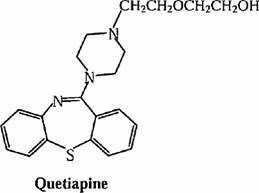Teva was unable to show inequitable conduct in its attempt to get AstraZeneca’s U.S. Pat. No. 4,879,288 declared invalid when the district court ruled that there wasn’t sufficient evidence that, in prosecution of the subject patent application in the Patent and Trademark Office, AstraZeneca made a misrepresentation of material fact or an omission of material fact to the patent office, with intent to deceive or mislead the patent examiner into granting the patent.
This is serious business since the determination that there is inequitable conduct in obtaining the patent, the district court may in its discretion declare the patent permanently unenforceable. Here, the court found that AstraZeneca didn’t have to disclose all related test data. Astrazeneca Pharma v. Teva Pharma and Sandoz (2008-1 480, -1481).
The ’288 patent claims the antipsychotic drug quetiapine, which AstraZeneca markets under the brand name “SEROQUEL®.” This product is an “atypical” antipsychotic drug, which means that, unlike “typical” antipsychotics, it does not produce involuntary body movements including torsion spasms, muscle spasms and dystonia of the face, neck, or back with protrusion of the tongue, and tonic spasms of the limbs (dyskinesias).
The issue here relates to the extent to which the patent applicant, having fully disclosed the relevant prior art and having provided comparative data to the satisfaction of the patent examiner, must also present any additional unpublished information in the applicant’s possession concerning other less structurally similar compounds, and must also synthesize additional compounds for comparative testing.
AstraZeneca filed an Information Disclosure Statement (“IDS”) listing several references including Compound 21076, Compound 24028, Perlapine and Fluperlapine. AstraZeneca had internal test data for these four compounds — as well as for many other compounds — not included in its IDS. AstraZeneca’s data showed that some prior art compounds potentially exhibited atypical antipsychotic activity, and Teva argued that this information should have been reported to the patent examiner.
During the prosecution the applicant and the examiner discussed the prior art compounds, which had small structural differences among these various compounds. The examiner based a rejection on structural similarity alone, and the applicant in response pressed the unpredictability of the critical physiological property of atypicality, and that the prior art provided no reason to make the particular compound quetiapine for the purpose of obtaining atypical antipsychotic properties. AstraZeneca pointed to the long-felt need for such a drug, because the use of clozapine was severely limited and no suitable replacement was available in the United States.
The examiner stated that in order to overcome the structural obviousness rejection AstraZeneca must provide proof that the prior art compounds:
do not necessarily or inherently possess the characteristics of the claimed product. . . . In other words, once a condition of prima facie structural obviousness has been made out, it must be overcome by a side-to-side comparison with the closest art compound(s). In this case, one would test both the prior art species ([Horrom compound] and [Schmutz X]) and the claimed specie for their ability to avoid e.g. tardive dyskinesia (or whatever undesirable side effect applicant wishes to focus on).
AstraZeneca submitted the test data in a declaration of one of the inventors, Dr. Migler. Teva argued that AstraZeneca did not submit to the PTO its internal test data for perlapine, fluperlapine, compound 21076, and compound 24028. Teva tried to show that it was a material withholding to provide test data only for the compounds on which the examiner relied, stating that AstraZeneca’s internal test data showed that compounds other than quetiapine possessed potential atypical antipsychotic activity. Thus, they argued that the Migler Declaration was deliberately misleading.
The district court found that AstraZeneca properly addressed the closest prior art, in response to the examiner’s specific requests, and that the premises of the factual allegations of material withholding with deceptive intent had not been shown sufficiently to avoid the grant of summary judgment, citing that inequitable conduct in patent prosecution requires proof by clear and convincing evidence of both (1) an affirmative misrepresentation of material fact, a failure to disclose material information, or submission of false material information, and (2) an intent to deceive the examiner by such material falsity.
Here, the Court of Appeals for the Federal Circuit agreed:
Although there may be situations in which the failure to conduct specific tests of specific compounds can be criticized, in this case there was no evidence that the information gleaned, if such tests had been conducted, would have been material to patentability. It was not disputed that it was unpredictable whether a given compound would exhibit atypical antipsychotic properties. The record demonstrates that structural similarity is not a predictor of whether antipsychotic behavior would be typical or atypical. As AstraZeneca points out, the properties of these structurally similar compounds vary significantly with minor structural changes.
The Appellants also argue that AstraZeneca should have submitted to the examiner its existing test data for Compound 24028 because Compound 24028 and Schmutz B are “equally close” to quetiapine. The Appellants state that the data should have been submitted although not identified or requested by the examiner.
To ascertain what is “equally close,” in identifying the structurally closest prior art, the compounds are viewed as they would be perceived by persons experienced in the particular field of science. Precedent suggests that as a starting point it is useful to ascertain the common elements of the claimed invention and the prior art.
We conclude, as did the district court, that the evidence cannot support a finding that AstraZeneca misrepresented or omitted material information.

